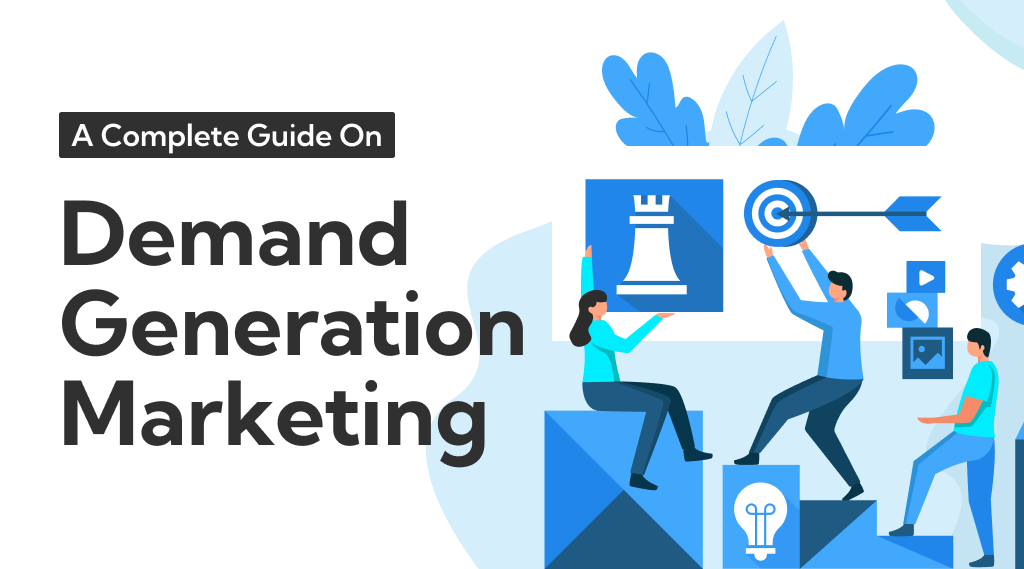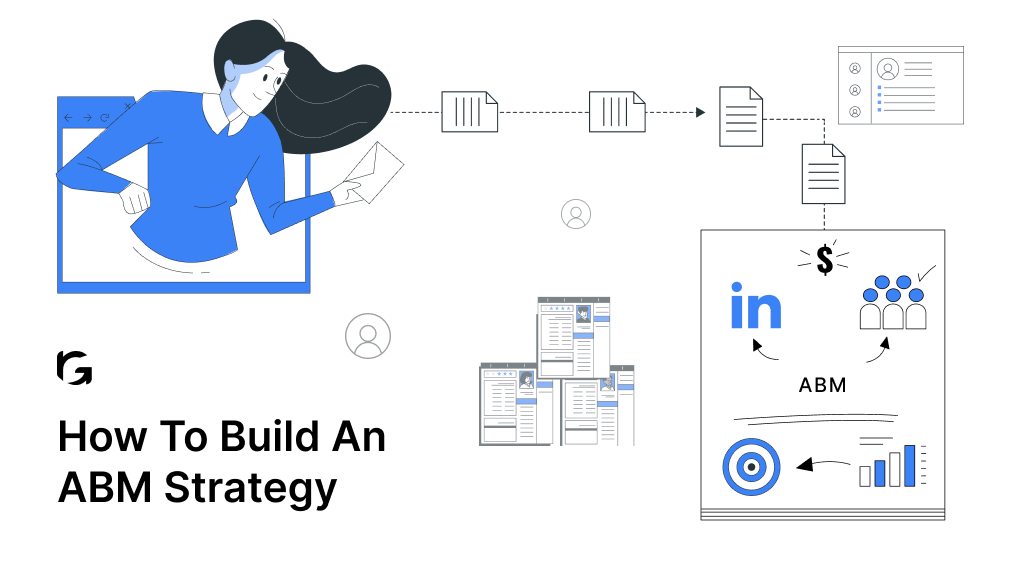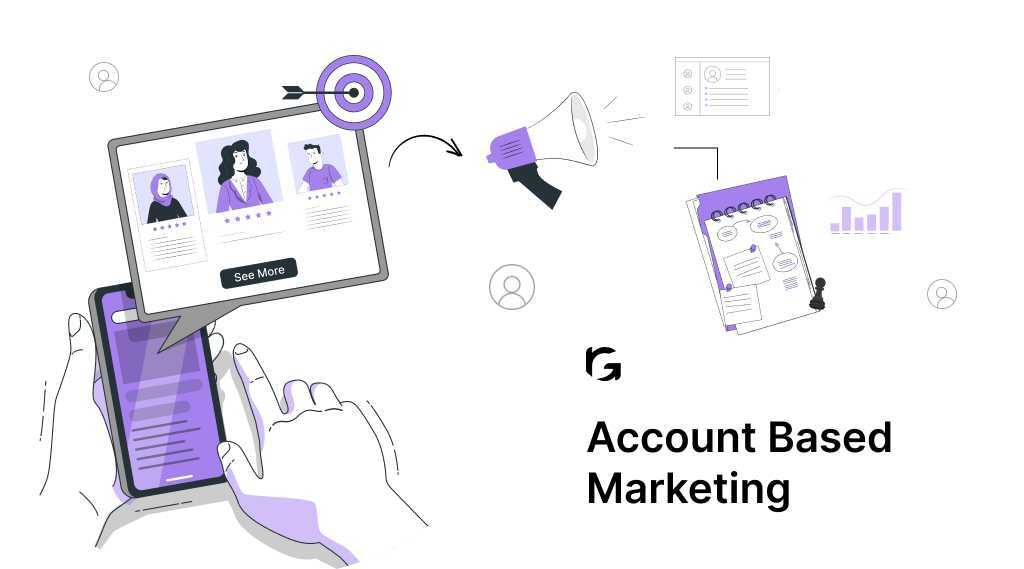Introduction
Demand generation marketing is a strategic approach focused on creating awareness and interest in a product or service to drive customer engagement and ultimately generate demand. It aims to cultivate interest among potential customers, guiding them through the sales funnel and encouraging conversions.
This form of marketing encompasses various tactics such as content marketing, social media campaigns, SEO, email marketing, webinars, and targeted advertising. By delivering valuable and informative content, demand generation aims to build relationships with potential customers, nurturing their interest and trust in the brand.
The primary goal of demand generation is not just immediate sales but to create long-term customer relationships and brand loyalty. It concentrates on educating and engaging prospects, ensuring that when they’re ready to make a purchasing decision, the brand is at the forefront of their minds. Through personalized and targeted strategies, demand generation marketing drives lead generation, ultimately contributing to revenue growth and sustained business success.
What Is Demand Generation In Marketing?
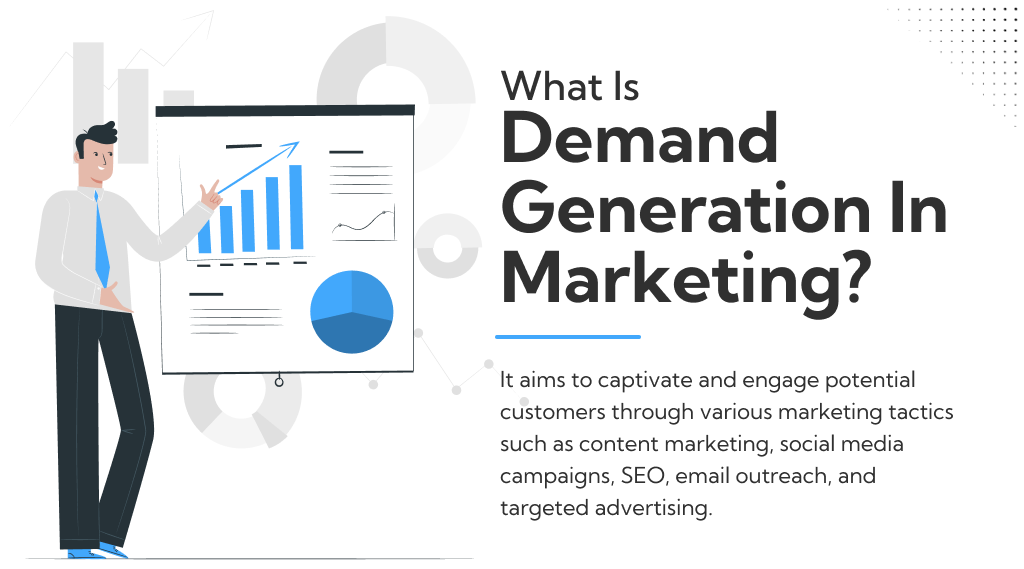
Demand generation in marketing is a strategic process that focuses on creating and nurturing consumer interest in a product or service. It aims to captivate and engage potential customers through various marketing tactics such as content marketing, social media campaigns, SEO, email outreach, and targeted advertising.
Unlike lead generation, which concentrates on acquiring contact information, demand generation concentrates on driving awareness and interest. Its objective is to build brand awareness, establish trust, and cultivate relationships with prospects.
By delivering valuable and educational content, demand generation seeks to guide consumers through the buying journey, ultimately resulting in increased demand for the product or service. Its goal is not just immediate sales but long-term customer loyalty and advocacy by influencing consumer behavior and fostering a strong connection between the brand and its audience.
Demand Generation Marketing : How Does It Work?
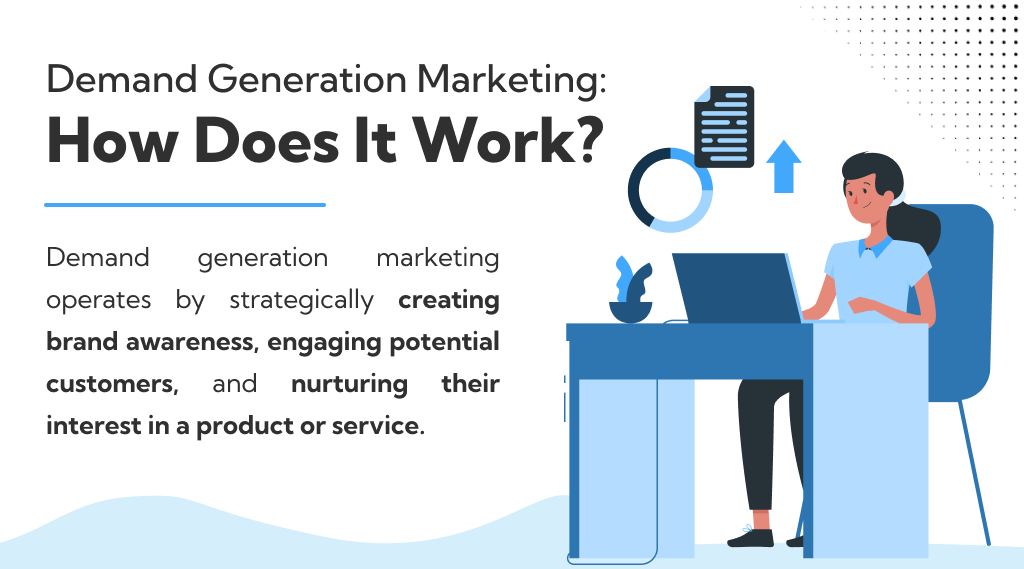
Demand generation marketing operates by strategically creating brand awareness, engaging potential customers, and nurturing their interest in a product or service. This process begins by identifying and understanding the target audience. Through various channels like content marketing, social media, SEO, email campaigns, and targeted advertisements, it delivers relevant and valuable content tailored to the audience’s needs and pain points.
The approach aims to educate and guide prospects through the buyer’s journey, building trust and credibility in the brand. By consistently providing valuable information and experiences, it establishes a connection with potential customers, encouraging them to engage with the brand. Tracking and analyzing consumer behavior and interaction help refine strategies, optimizing the nurturing process.
Ultimately, demand generation aligns marketing and sales efforts to create a continuous flow of qualified leads, moving them towards conversion and fostering long-term customer relationships. It’s a cyclical process that drives demand by creating meaningful interactions and influencing consumer behavior.
What Are The Three Pillars Of Demand Generation?
The three pillars of demand generation are:
1. Content Strategy: Central to demand generation, a robust content strategy involves creating valuable, relevant, and targeted content across various channels. This content educates, engages, and nurtures potential customers throughout their journey. It includes blog posts, videos, whitepapers, webinars, and more, tailored to address the audience’s needs and pain points.
2. Multi-channel Marketing: Leveraging multiple channels such as social media, email marketing, SEO, paid advertising, and influencer partnerships maximizes brand visibility. Coordinated, integrated campaigns across these platforms ensure consistent messaging, optimizing outreach and engagement.
3. Data and Analytics: Data-driven decision-making is crucial. Analyzing consumer behavior, tracking interactions, and understanding campaign performance help refine strategies. Metrics like conversion rates, click-through rates, and engagement metrics guide adjustments and optimizations, ensuring continuous improvement in the demand generation process.
Integrating these pillars harmoniously forms a strong foundation for effective demand generation, ensuring a holistic approach that educates, engages, and converts potential customers.
What Is Demand Generation Marketing Objectives
The objectives of demand generation marketing revolve around creating brand awareness, nurturing leads, and driving customer engagement to ultimately generate demand for a product or service. Its primary goal is to educate and inform potential customers, building trust and credibility in the brand.
By delivering valuable content tailored to the target audience, it aims to guide prospects through the buyer’s journey, from initial awareness to consideration and decision-making, leading to increased sales and conversions.
Demand generation strategies focus on establishing long-term customer relationships, fostering brand loyalty, and influencing consumer behavior. Its objectives include expanding the customer base, maximizing brand exposure across various channels, generating qualified leads, and ensuring a seamless transition from interest to purchase.
Data-driven optimizations and continuous improvements in marketing initiatives contribute to achieving these objectives, resulting in sustained revenue growth and a strong market presence.
What Is Demand Generation Marketing Strategy?

Demand generation marketing strategy involves a multifaceted approach aimed at creating brand awareness, nurturing potential leads, and stimulating customer interest.
It relies on a mix of tactics such as content marketing, social media engagement, SEO, email campaigns, and targeted advertising to engage and educate the target audience. By delivering valuable and relevant content tailored to the audience’s needs, the strategy aims to guide them through the buying journey, establishing trust and credibility in the brand.
The focus is on generating and nurturing leads, aligning marketing and sales efforts, and analyzing consumer behavior to refine strategies continuously. The strategy aims to create a consistent flow of qualified leads, driving conversions, and fostering lasting customer relationships by influencing consumer behavior and establishing a strong brand-consumer connection.
How Do You Start A Demand Generation Strategy?
To start a demand generation strategy, begin by understanding your target audience and their needs. Develop buyer personas to guide your approach. Create valuable and relevant content tailored to their pain points and interests.
Utilize various channels like social media, SEO, content marketing, and email campaigns to reach and engage potential customers. Implement lead capture methods on your website to gather prospect information.
Align sales and marketing efforts to ensure a seamless transition for leads through the sales funnel. Set clear goals and metrics to measure success. Continuously analyze data and consumer behavior to refine strategies.
Focus on creating educational content to guide prospects through their buying journey, establishing trust and credibility in your brand. Optimize and adjust strategies based on insights gathered. This cyclical process of understanding, engaging, and nurturing leads forms the foundation of a successful demand generation strategy.
Key 5 Demand Generation Metrics To Track
1. Lead Conversion Rate: This metric measures the percentage of leads that progress through the sales funnel and convert into customers. It assesses the effectiveness of your nurturing efforts.
2. Cost Per Lead (CPL): CPL calculates the cost incurred to acquire a single lead. It helps evaluate the efficiency of your marketing campaigns and assists in budget allocation.
3. Marketing Qualified Leads (MQLs):MQLs represent leads more likely to become customers based on their interactions. Tracking MQLs indicates the quality of leads generated and helps focus efforts on those more likely to convert.
4. Website Traffic-to-Lead Ratio: This ratio measures the percentage of website visitors who become leads. It assesses the effectiveness of your website in converting visitors into potential leads.
5. Customer Acquisition Cost (CAC): CAC evaluates the cost of acquiring a new customer. Understanding this metric aids in determining the overall efficiency and sustainability of your demand generation efforts in relation to revenue. Tracking these metrics provides insights into campaign performance, lead quality, and the overall effectiveness of demand generation strategies.
7 Demand Generation Marketing Trends
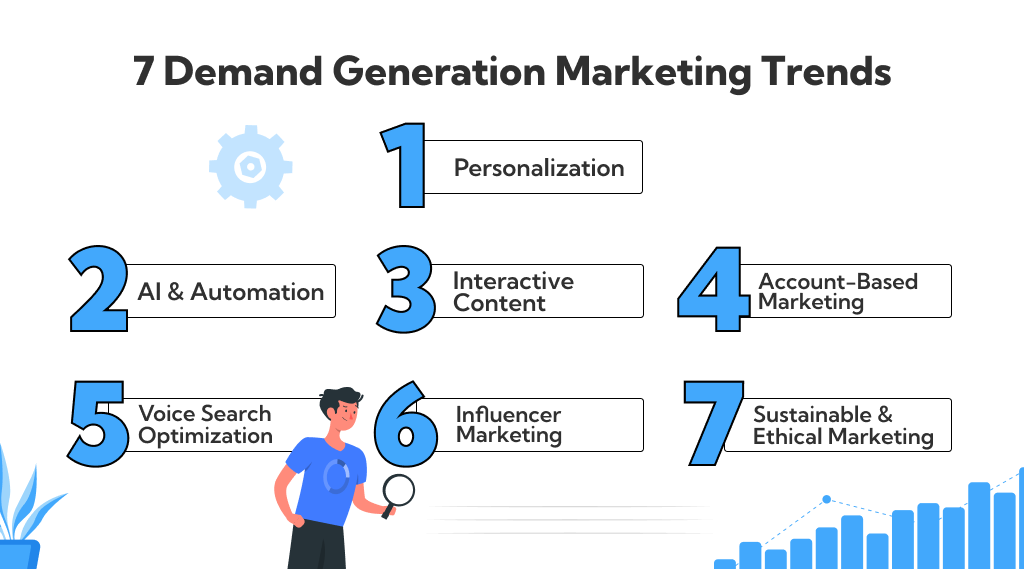
1. Personalization: Tailoring content and experiences based on individual preferences and behaviors enhances engagement and conversion rates.
2. AI and Automation: Leveraging artificial intelligence for personalized recommendations, chatbots, and automated marketing processes streamlines operations and improves customer interactions.
3. Interactive Content: Interactive formats like quizzes, polls, and interactive videos engage audiences, fostering higher involvement and data collection.
4. Account-Based Marketing (ABM): ABM focuses on targeting specific high-value accounts with personalized campaigns, enhancing engagement and conversion within targeted organizations.
5. Voice Search Optimization: Optimizing content for voice search aligns with the increasing use of voice assistants, enhancing visibility and accessibility.
6. Influencer Marketing: Partnering with influencers allows brands to reach niche audiences effectively and build trust through authentic recommendations.
7. Sustainable and Ethical Marketing: Consumers prioritize brands committed to sustainability and ethical practices. Marketing strategies focusing on social responsibility and environmental consciousness resonate strongly with modern audiences. Embracing these trends enables businesses to stay competitive and relevant in the ever-evolving landscape of demand generation marketing.
Conclusion
Demand generation marketing is a dynamic strategy focused on engaging, nurturing, and converting potential customers by delivering valuable, personalized content across various channels. It aims to build brand awareness, trust, and lasting customer relationships. Embracing key trends like personalization, AI integration, interactive content, and ethical marketing practices enhances its effectiveness.
By tracking crucial metrics like lead conversion rates, cost per lead, and website traffic-to-lead ratio, businesses can refine their strategies for optimal performance. As the marketing landscape evolves, staying adaptable and integrating these trends enables companies to stay competitive, resonate with audiences, and drive sustainable growth in today’s dynamic market.
Understanding and harnessing these trends are pivotal in shaping successful demand generation strategies, ensuring businesses connect effectively with their audience and drive demand for their products or services.
Supercharge Your Marketing Efforts with RevvGrowth – Your Trusted SaaS Marketing Partner! Get Started Today.

